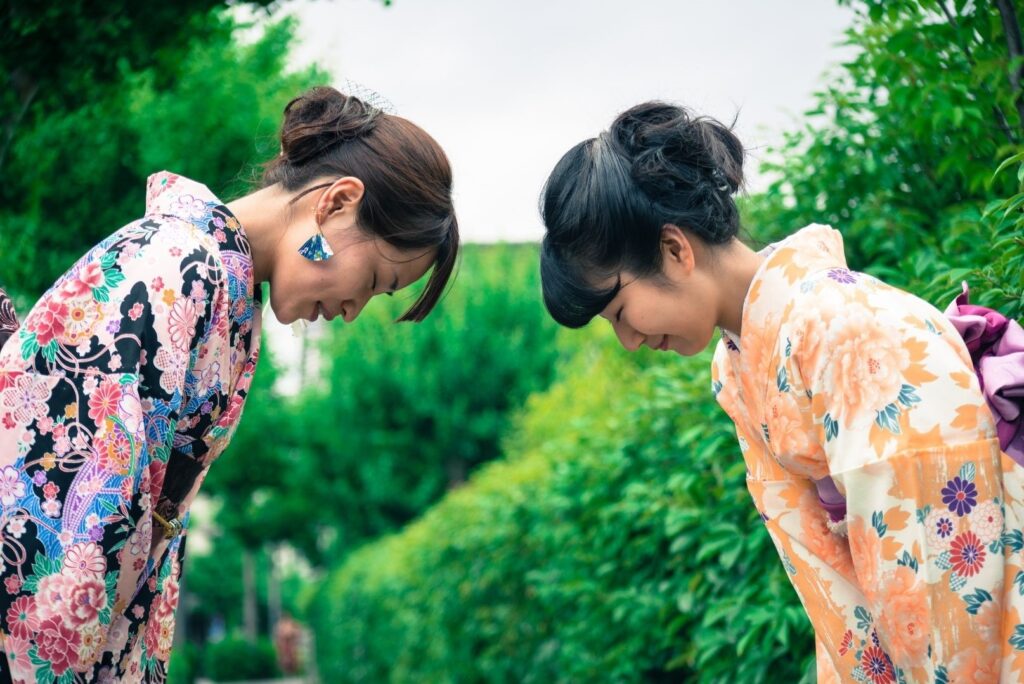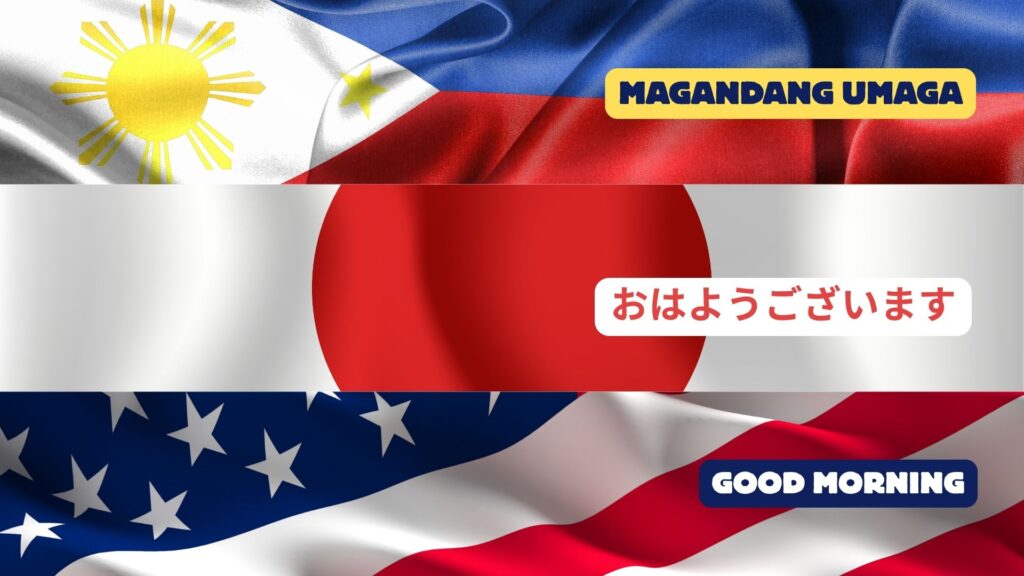
Deep Dive into Japanese Greetings: Ohayou to Yoroshiku in Your Nihongo Class
JLRC – Content Team
2025/10/04

Greetings are often the first words students memorize in their Nihongo class, yet in Japanese they represent much more than simple polite formulas.. Expressions such as おはようございます (Ohayou gozaimasu), こんにちは (Konnichiwa), こんばんは (Konbanwa), はじめまして (Hajimemashite), and よろしくお願いします (Yoroshiku onegaishimasu) are not just casual “hellos.” They are miniature stories of Japanese culture—echoes of older grammar, expressions of humility, and reflections of the country’s emphasis on harmony.
By understanding the deeper meanings and origins of these Japanese greetings, and by comparing them with English and Filipino expressions, Nihongo learners can appreciate not only the words themselves but also the cultural values they embody.
Table of Contents
1. The Deeper Meaning of Japanese Greetings – More Than Just “Hello”
Unlike many Western greetings, Japanese greetings are not mere casual exchanges. They carry layers of respect, humility, and social awareness. In fact, many common greetings in Japanese are actually abbreviated sentences rooted in classical grammar. They acknowledge not only the presence of another person but also the time of day, the relationship between speaker and listener, and a shared sense of harmony.
Let’s explore some fascinating details.
おはようございます (Ohayou gozaimasu) – “It’s Early”
The word ohayou comes from the adjective 早い (hayai = “early”), with the polite prefix o-. So originally, it literally meant: “It’s early, isn’t it?” In Edo-period Japan, meeting someone in the morning was often expressed this way, as if to say, “You’re up early.”
Over time, it became a general morning greeting, and adding ございます gave it formality, turning it into something appropriate for any social setting. Even today in Japanese companies, colleagues who arrive at the office at 10 AM may still say ohayou gozaimasu, because the phrase has less to do with clock time and more to do with starting a shared day together.
It’s not just “Good morning.” It’s a way of acknowledging the beginning of a relationship for that day.
こんにちは (Konnichiwa) – “As for Today…”
Here’s a phrase with a hidden story. Written as こんにちは(今日は), konnichiwa literally means, “As for today.” In classical Japanese, the particle は (wa) was used to set the topic of a sentence—just like in “今日はご機嫌いかがですか” (Konnichi wa gokigen ikaga desu ka) (As for today, how are you?).
Over centuries, the second half of the sentence was dropped. What remained was simply the topic marker 今日は, spoken with the particle は but pronounced as wa (because that’s how the topic particle is read).
That’s why it’s konnichiwa (wa) and not konnichiha (ha). What looks like a spelling inconsistency is actually a grammatical trace from older Japanese usage.
So every time you say konnichiwa, you’re echoing a polite phrase that once carried the full meaning: “As for today, are you well?” It is less casual than “hello” and more of a polite acknowledgment of the present moment and the other person’s condition.
こんばんは (Konbanwa) – “As for This Evening…”
Just like konnichiwa, こんばんは (konbanwa) comes from 今晩は—“As for this evening…” Again, the original sentence likely continued with something like “ご機嫌いかがですか” (Konban wa wa gokigen ikaga desu ka) (How are you this evening?). Over time, only the opening phrase survived.
Thus, greetings in Japanese are often fragments of once-complete sentences. This structure reflects the culture’s tendency toward politeness, indirectness, and efficiency—expressing warmth while leaving things unsaid.
はじめまして (Hajimemashite) – “This is Our First Time”
At first meetings, Japanese speakers traditionally begin with hajimemashite. This comes from the verb 始める (hajimeru = to begin), in the polite form meaning “As this is the first time [we meet].”
The unspoken continuation is “どうぞよろしくお願いします” (Douzo yoroshiku onegai shimasu) (I humbly ask for your kindness). So hajimemashite is not just “Nice to meet you.” It’s a recognition that this is the start of a relationship, and the phrase itself carries a sense of responsibility and respect toward what will follow.

よろしくお願いします (Yoroshiku onegaishimasu) – “Please Treat Me Kindly”
Perhaps the most uniquely Japanese greeting. Literally, it means “I humbly request that you regard me favorably.” But culturally, it’s far more than that.
- When you say it after hajimemashite, it’s a pledge of goodwill for your new relationship.
- When said before working on a project, it means, “Let’s cooperate harmoniously.”
- Even at the end of an email, it implies, “I trust in your support.”
It’s not about one single interaction, but about establishing an ongoing bond based on mutual effort and consideration. That’s why it’s often described as “untranslatable”—because it embodies values of cooperation, respect, and humility deeply rooted in Japanese culture.
2. Comparing Japanese, English, and Filipino Greetings

English Greetings
English greetings like “Good morning,” “Good afternoon,” and “Good evening” are close parallels to Japanese expressions, but they are less formalized. English also relies heavily on casual all-purpose greetings like “Hi” or “Hey,” which have no direct equivalent in polite Japanese.
“Nice to meet you” works as a translation of hajimemashite, but it lacks the ritualistic weight. Skipping “Nice to meet you” in English may be forgiven, but skipping hajimemashite in Japanese would feel incomplete.
English lacks a direct equivalent of yoroshiku onegaishimasu, though phrases like “I look forward to working with you” come close.
Filipino Greetings
In the Philippines, greetings reflect warmth and inclusiveness:
- Magandang umaga / hapon / gabi – Literally “beautiful morning/afternoon/evening,” expressing positivity..
- Kumusta? – From Spanish “¿Cómo está?”, meaning “How are you?” Used casually, often as a friendly hello.
- Respect markers like po and opo show politeness, similar to adding ございます in Japanese.
Compared to Japanese, Filipino greetings are more about friendliness and optimism than formality and structure. Where Japan emphasizes hierarchy and harmony, the Philippines emphasizes warmth and community.
3. Why Cultural Nuance Matters for Learners
For learners of Japanese language, greetings are not just words to memorize. They are cultural signals.
- Saying ohayou gozaimasu at the office shows you understand Japanese workplace culture.
- Using hajimemashite and yoroshiku onegaishimasu shows respect and awareness when meeting new people
- Recognizing why konnichiwa uses / pronounces “wa” instead of “ha” gives you insight into Japanese grammar and history.
4. Final Thoughts
Japanese greetings are living fragments of history. What we casually say today—konnichiwa, konbanwa, ohayou gozaimasu—were once full sentences like “As for today, how are you?” or “It’s early, isn’t it?”
They carry respect, humility, and cultural nuance in ways that English or Filipino greetings do not. Learning these subtleties helps you connect more deeply with Japanese speakers, not just through words, but through understanding.
As such, even a single greeting can teach us Japanese culture. The more you study the Japanese language, the more you discover its spiritual and cultural dimensions , exploring the culture and history behind every expression—making the journey both meaningful and fascinating.
👉Join JLRC’s Japanese classes and begin your Nihongo journey with us today, and discover how even the simplest greeting—ohayou gozaimasu or yoroshiku onegaishimasu and more—can open doors to real understanding in Nihongo.

For inquiries, you may call us at (63)2-7358-0565 or (63)917-163-3371
Japanese Language Research Center
Unit 506 Cityland Shaw Tower, Shaw Blvd, Mandaluyong, 1552 Metro Manila, Philippines

For inquiries, you may call us at (63)2-7358-0565 or (63)917-163-3371
Japanese Language Research Center
Unit 506 Cityland Shaw Tower, Shaw Blvd, Mandaluyong, 1552 Metro Manila, Philippines
Copyright © 2024 JLRC Inc.
All Rights Reserved
